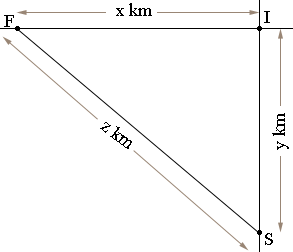| |||
| Math Central | Quandaries & Queries |
|
Question from Michael, a student: Hi there, I'm in grade 12 and I'd like some help in approaching this problem. Two cars approach a right-angled intersection, one traveling south a 40km/h and the other west at 70km/h. Many thanks in advance! Michael |
Hi Michael,
In my diagram I is the intersection, F is the position of the fast car and S is the position of the slow car at some time $t$ hours. The distances from the cars to the intersection and the distance between the cars are changing so $x, y$ and $z$ are functions of time, that is $x = x(t), y = y(t)$ and $z = z(t).$

Since $IFS$ is a right triangle Pythagoras theorem gives us that
\[x(t)^2 + y(t)^2 = z(t)^2\]
Differentiate both sides of the equation with respect to $t$ to obtain an equation containing $x(t), x'(t), y(t), y'(t), z(t)$ and $z'(t).$ You know that $x'(t) = 70$ km/hr and $y'(t) = 40$ km/hr. Also at some particular time $t_0$ you know that $x(t_0) = 4$ km and $y(t_0) = 3$ km. What are $z(t_0)$ and $z'(t_0)?$
Penny
 |
||
Math Central is supported by the University of Regina and The Pacific Institute for the Mathematical Sciences.